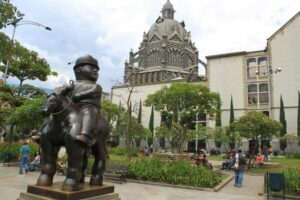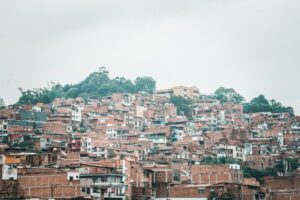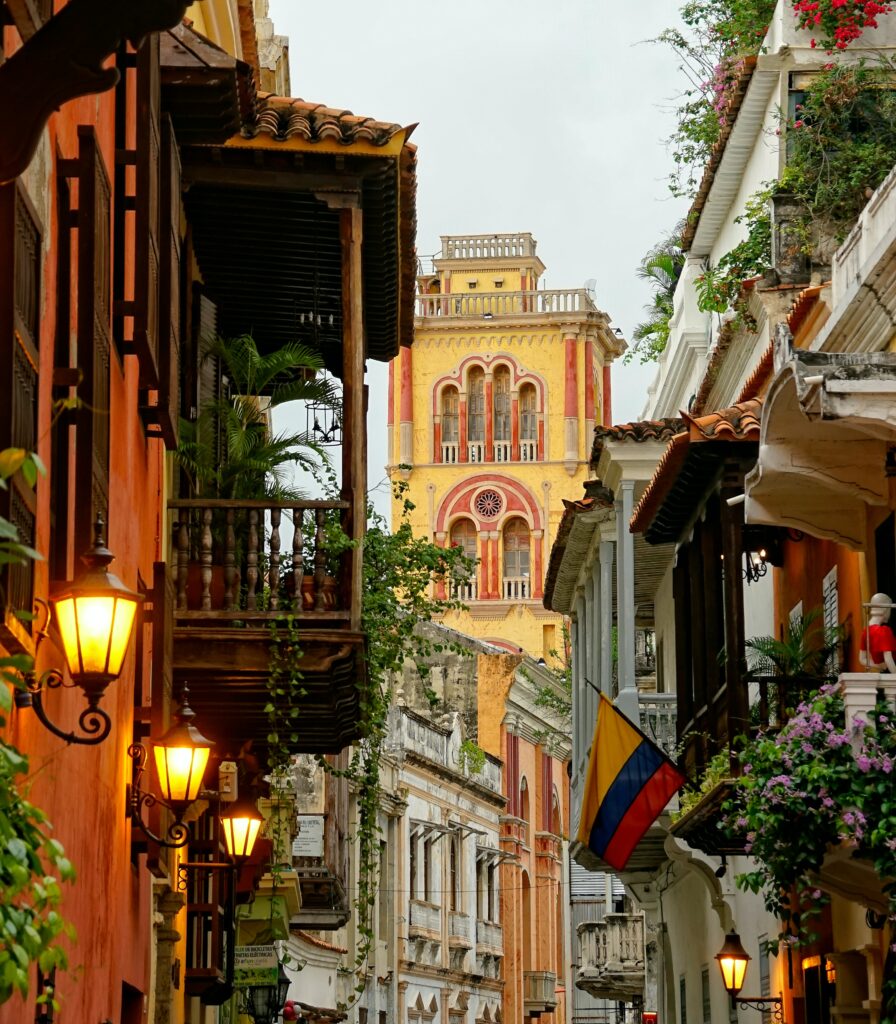Tourists and digital nomads flock to Medellin, Colombia for many reasons, among them the Medellin “must see” attractions. It is, after all, called “The City of Eternal Spring” for its temperate climate. Year round, the average temperature hovers around 80 degrees during the day and drops into the low 60s at night, making the weather perfect year-round for seeing the sites.
Medellin is indeed a gorgeous city settled in the Aburrá valley, 4900 feet above sea level with a rich cultural history and much beauty. It’s the second largest city in Colombia with a population of 4,120,000. (Bogota is the most populated city.) To fully embrace your experience, here are just a few of Medellin’s must-see sites.
Medellin Must See: Parque Arvi
Lots of people come to Medellin for the natural settings that encourage adventure tourism. Parque Arvi, (Arvi Park) is one of those Medellin must see destinations. In this 39,500 acre nature reserve, opportunities for rock climbing, paragliding, horseback riding, and bicycling abound.
Hikers delight in more than 33 miles of walkable trails surrounded by more than 70 species of birds and butterflies, along with 19 species of mammals.
Five smaller parks are nestled within the massive Parque Arvi, including areas with pre-Spanish historic buildings and a trail that is more than 1500 years old.
On the weekends, more than 40 vendors display their arts, crafts, and luscious produce, making shopping a popular activity.
Medellin Must See: The Botanical Garden of Medellin
Nature lovers flock to the Botanical Garden of Medellin, which has almost 35 acres of gorgeous plantings containing 4500 species of flower and orchids and more than 1000 species of trees and plants.
Established in 1972, the Botanical Garden of Medellin has more than a half a century of work in propagating plants and developing seed banks to conserve Colombia’s vast and diverse plant life.
The Botanical Garden hosts events, activities, and educational events in a green space worthy of visiting!
Medellin Must See: Museo de Antioquia and Plaza Botero
Art and history lovers often travel to Medellin to view the Museo do Antioquia and Plaza Botero.
Museo de Antioquia
This museum was originally founded in 1881 but over the years has changed and evolved. It is now housed in the old Municipal Palace and showcases an impressive collection of art. Artifacts from Colombian history, like weaponry, ceramics, and gold craftsmanship are showcased along with works of contemporary local artists like Debora Arango and Pedro Nel Gomez.
Many art lovers come to view the works of Colombian artist Fernando Botero. The Museo de Antioquia boasts the largest collection of Botero artworks in the world, including more than 120 of his paintings.
Plaza Botero
Another of Medellin’s must-see sites is located directly in front of the Museo de Antioquia.
Plaza Botero is a 75,347 square foot, open-air plaza perfect for the display of Botero’s unmistakably sized sculptures. Twenty-three of the artist’s wildly popular hefty statues are positioned around the area, making for a great viewing experience from all angles.

So much more to see and know about Medellin
Medellin’s temperate climate is just one of its many attractions. In addition to Medellin’s must-see sites, there are cultural perks that visitors from all over the world come to experience. The annual flower festival, the coffee culture, the parks, the local markets, Pablo Escobar tours, metro cable rides, and the vibrant night life are just a few of the enticing facets of life in Medellin, Colombia.
But there is another side to life in today’s “City of Eternal Spring.”
While monied tourists arrive daily, while the digital nomad community keeps growing, and while ex-pats settle here because of Medellin’s many amenities and vast appeal, thousands of poor people living in a different part of the city suffer here, struggling to survive.
A tale of two cities
It’s almost as if Medellin is a tale of two cities. One is clean and colorful, thriving and thoughtful, rich and wonderful.
The other is most definitely not. The other side of the city is sad and sordid, vicious and violent, dark and dismal.
Tens of thousands of impoverished people live in the slums, the “inquilinatos” of Medellin.
The inquilinatos are dilapidated tenements built on the sides of the mountains that surround the city. Here, families must pay by the night to sleep. Unattended children languish their days away in rooms where parents have secreted them away from gangs, drug dealers, and the lurking danger of those working to find kids for the sex trade.
Medellin has many must see attractions, but it also has many debilitating hard truths you must know.

Medellin Must Know: Poverty is commonplace
A vast divide exists between the affluent areas of Medellin and the inquilinatos.
The top 10% percent of the population earns more than 40% of the country’s income. A huge gap exists between the wealthiest and the poorest, and that gap is getting wider.
Nearly 30 percent of all families in Colombia don’t have adequate homes according to Ministry of Housing estimates. Almost five percent of the population is homeless.
In Medellin, most of the poor live in the inquilinatos. Multiple families live on a single floor with only one bathroom and kitchen. Dozens of people cram into a space barely big enough for two just to have some small protection from sleeping on the street. The buildings are dirty and in disrepair.
Here, no one mandates that children attend public school. The lack of education solidifies the cycle of poverty.
Medellin Must Know: The sex trade and narco tourism are major draws to the city
Have you heard the name Pablo Escobar?
He was the kingpin and founder of the Medellin drug cartel in the 1980s. He rose to political power and became one of the wealthiest men in the world during the 1990s when he established a lucrative cocaine trade by trafficking in the United States and Europe.
Medellin has cleaned up violent crime in some areas of the city. Officials have made an effort to beautify certain spots and polish the tarnished reputation of Medellin since the time of the infamous Pablo Escobar, but the sex trade and narco tourism still thrive.
Many visitors come to Medellin with the sole purpose of easy access to legal prostitution.
Sadly, while prostitution is legal here, the legal age is eighteen, yet many children are lured, coerced, or kidnapped into the sex trade.
Many young women are leading desperate lives in the City of Eternal Spring where some foreign tourists come to exploit them. Often, these young women have been drugged or plied with alcohol to make them less afraid or rebellious. “Pimps” force drinking and drugging on their girls, causing a sad cycle of addiction that seems impossible to break.
Medellin has thousands of children and young women in need of help.
Medellin Must Know: Casa de Sueños offers help to the poor children and abused young women of Medellin
There are lots of Medellin must-see attractions, but there are lots of other sites you might not see but that are essential to know about. If you are going to understand the true Medellin, you need to see the two sides of life going on here.
If you have visited this lovely city, you will understand its appeal. You know about the great coffee, the tasty cuisine, the unbelievable natural surroundings for hiking. You have experienced the art and horticulture of this remarkable place.
If you weren’t aware of the struggles of the poor and downtrodden living in the less “touristy” areas, you are now.
If you care at all about Medellin and its future, you will want to know about Casa de Sueños.
Casa de Sueños is the premier nonprofit foundation in Medellin for helping children and the poor, abused young women. The organization boasts two award-winning programs that support, nurture, educate, and feed these souls in need of help.
You can help, too…because there’s more to loving a place than seeing the sites.
There’s more to life than globetrotting.
If you have the means to travel to Medellin, you also have the means to help the poor and impoverished children who live here. You can ensure that the sad and often unseen side of the city gets better.
YOU can improve the life of a child with your donation to Casa de Sueños enabling vital programs of healing and help to continue.
YOU can improve the future of The City of Eternal Spring.
With YOUR help, Medellin can also be a city where hope springs eternal.
For the less fortunate poor and abused children among us.
Donate now.

